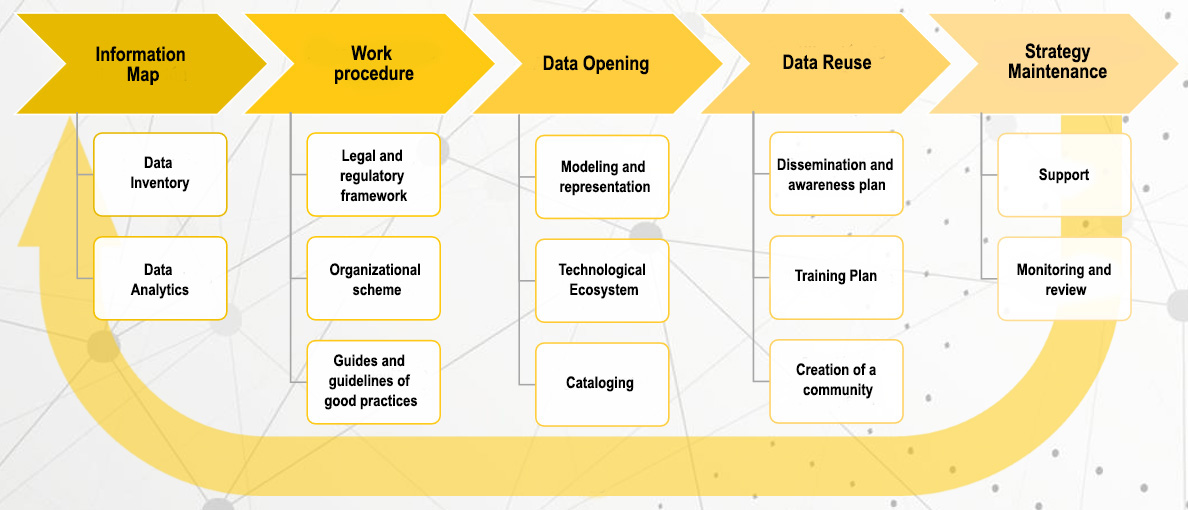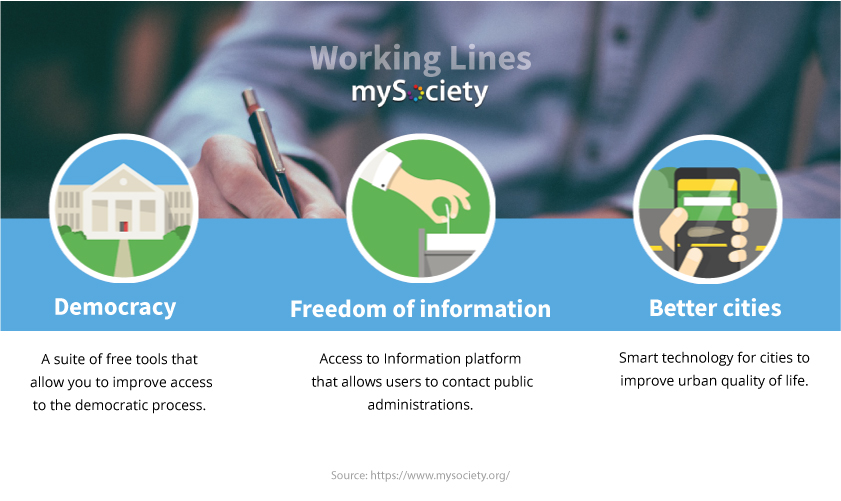Why are open data important? What is their relationship with open government? How can I start an initiative of this kind? Who can I take as a reference? These are some of the questions that the Open Data Guide: Publication and reuse of Open Data as an initiative of Open Government in the Administration tries to answer
Prepared by the Ministry of Development and Environment of the Junta de Castilla y León, this guide is part of the Rural Digital Community (CRD), a collaboration project between Public Administrations of Portugal and Spain. The objective of the project is to improve the technological innovation of rural institutions, promoting cooperation and competitiveness.
The guide is divided into 5 sections: introduction to open data, current status of open government and open data, open data implementation , innovative solutions and success stories, and conclusions.
In the first introductory section, perfect for those unfamiliar with the open data world, some basic concepts are reviewed. The report focuses on open government as a sociopolitical mode of interaction based on 4 pillars - transparency, accountability, participation and collaboration - which can be promoted and improved thanks to open data. All this is explained in this section, which also describes the principles that data must meet to be considered open.
Next, the report address the current situation of open government and open data in Spain, Portugal and Europe, including existing regulations. In the case of Spain, the report highlights the existence of almost 300 initiatives, included in the initiatives map of datos.gob.es, as well as more than 660 companies that reuse information, with a business volume higher than 1,700 million euros per year. These data, together with the good position of Spain in the European Open Data Maturity Landscaping 2018 report, show the good momentum of open data in our country.
The third section of the report focuses on the implementation of open data in an organization. To facilitate this process, the authors of the guide have drawn up a plan with a series of stages that are detailed in the report:

Finally, the report shows several examples of innovative solutions and success stories, based on 2 criteria:
- Examples of open data portals, which stand out for their functionality, such as Aragon Open Data or the download center of the National Geographic Institute (IGN), among others.
- Examples of good practices regarding reuse, due to their innovative nature and the economic or social value they generate. Examples of different sectors are included, such as real estate (TerceroB), meteorological (Meteogrid), public procurement (EuroAlert) or data journalism and public transparency (Civio).
The report concludes with a series of conclusions, such as the need to improve the training of both public employees who are immersed in data opening and companies and individuals to promote the use and analysis of data.
Below you can download the full report and delve into all of these sections.
mySociety is a non-profit organization based in the UK and working with partners internationally, whose general goal is creating tools and mechanisms to ensure and maximize democratic accountability to give people the power to control and participate in the political agenda.
Thus, the entity develops platforms where content is provided by users, re-using that information to create a database that is useful to other members of society: citizens, public servants, policy makers, etc. All products created by mySociety are structured around three areas: democracy, freedom of information and better cities.

mySociety began in 2004 with a simple application, WriteToThem, which gives the user the opportunity to meet their political representatives and contact them after entering the zip code. However, one of the most successful products internationally, which has been replicated in different places thanks to its free software, is the FixMyStreet platform. Through this project the UK population can report on local problems affecting their city, especially related to the streets and public spaces. This service has also been adapted to mobile devices and it sends to public servants the incidents detected so they can find a solution.
Beyond the development of online tools and platforms, the institution regularly organizes events around the world to show the impact of civic technologies in society. This is the case of the TICTeC Conference, held last April in Barcelona. For two days, 140 attendees from academia, public and business sector, NGOs and educational institutions met to discuss ideas, present research and build a network of people interested in civic technology, through which citizens collaborate with governments and participate in the processes.
The civic technology movement is still relatively young, when it began mySociety priority was to build the digital tools that would bring about change and to make them effective and easy to use. A decade later, the company has already acquired enough experience and knowledge in the field and it focuses its efforts on a research program to analyze the real impact of the tools and applications in the real world. Thus, it collaborates with academic institutions, researchers and international partners to regularly publish open reports, available to any user on a wide range of topics, all related to civic technology and its impact.
In a participative government citizens can access to information about their city and work on improving their environment. Thanks to initiatives like mySociety increasingly administrations are more participatory and invite the public to collaborate in making certain decisions, not only through voting but through dialogue and consultation. A firm step towards an open and collaborative government where all stakeholder work towards the common good.
As has been rightly highlighted, there is a tendency to use in a general manner concepts based on openness and data management and, also to link this to the need to strongly promote transparency and therefore, the democratic character of public institutions as well as the need to invest in technological innovation in order to make progress in controlling deviant behaviour. Moreover, the existence has been mooted of a direct relationship between participation and the openness of Government from the perspective of freedom of access to information in environments where ICTs are called to play a leading role to the extent that they help achieve those goals.
Nevertheless, at least from the standpoint of Law, there are certain important differences and an attempt will be made to clarify these in order to facilitate the implementation of the regulatory framework for each of the informative treatments. Although it is necessary to admit as an inexcusable premise that Open Government must be based on transparency as one of its main axes, this principle in itself cannot state unequivocally that data can be reused according to the criteria specific to open data. In this regard it needs to be pointed out that, from the legal point of view, in Spain there is no legal definition that uses this concept, so the analysis must be redirected to the regulatory framework on re-use of public sector information. Thus, one may discuss to what extent the forecasts thereof approach the open data model since they contemplate the possibility of setting charges for the provision of documents for re-use.
Although the regulation on transparency and access to public sector information establishes a clear obligation for active publicity through the websites of public institutions, which must be carried out in a clear, structured and understandable way, this only establishes a mere preference for reusable formats, without specifying the scope of that principle. In fact, as regards accessibility of information, the legislator is clear in stating that information disseminated under the legislation on transparency shall not only be accessible but also free, this requirement being incompatible with charging fees as mentioned above.
Even from the point of view of the relationship with the final beneficiaries -the public- in the case of the regulation on re-use the purpose of access is not the information itself but, on the contrary, the services provided by a third party - the so-called re-user agent in the national regulation - based on the data provided by public entities, so that they can even charge their customers for the added value provided by such services.
In conclusion, the different aims provided for by the two policy frameworks have an important consequence in terms of the possibilities for using the data and its limits. In this regard, the fact that certain data are published under the legislation on transparency does not involve by itself a tacit authorization for its re-use under the regulation of this last informative treatment, as shown by the existence of an administrative system for re-use which is based on the need for a license or even a prior authorization for the corresponding application and processing of an administrative procedure. Even, from the perspective of protection of personal data, there may be sufficient legal protection for the publication of information related to individuals under the law of transparency, which in no way means that treatment for re-use purposes is lawful.
However, it is unquestionable that the possibility of re-use of public sector information requires prior accessibility according to certain technical parameters and, in this sense, the regulation on transparency can contribute greatly to achieving shared goals. Therefore, taking into account the current -and advanced- technological context in which the activity of the public sector operates with the implementation of eGovernment, it seems that the time has come to address a joint regulation of both subjects committed to determinedly promoting transparency from the perspective of the re-use of information. Or, considering that the activity in which the data is generated is publicly funded, should we say instead from the perspective of open data? The debate is assured.